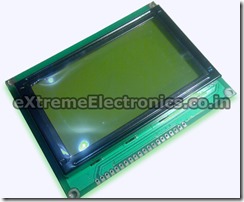This is going to be a mini-series on how to get started with a 128×64 LCD display. I’ll be going through all the steps that are involved in getting one of these damned things to work and I’ll post links and references wherever necessary.
“But”, you argue, “why do I need to learn this stuff? I can just whip out my Arduino and use the GLCD library and be just as cool!” Well, definitely. The purpose of doing this is not to be “cool”, but to gain an understanding into how this works and what kinds of problems you may face when working on something like this.
I won’t go too much into the pros and cons of which is a better approach. Obviously, libraries are there for a reason and if you’re using a specific development platform/board (Arduino, EasyPic) or a specific compiler for a certain project (AVR-GCC, MikroC, XC8) and you’re on a deadline and have a fairly straightforward task to accomplish, you should go ahead with that.
On the other hand, if LCD.Write(“Hello, World!”) doesn’t cut it anymore and you want to have complete control on a pixel to pixel basis, and/or be able to churn out your own library for a specific microcontroller that you’re currently using (8051, PIC, AVR, MSP) then you should read these series of posts.
On the whole, I will try to keep this series largely microcontroller agnostic. You should be able to read whatever is given here and transfer the learning to any microcontroller or development platform with a small amount of effort.
But for the sake of demonstration, I will be using a PIC16F886 microcontroller here. I have used both AVR and PIC and they’re both excellent microcontrollers in terms of performance, price and availability. But I’m going with a PIC here because I’m trying to learn more about these microcontrollers.
Here’s the table of contents. I will keep updating the links as I push content out:
- Intro – Getting started with a 128×64 Graphics LCD Display
- Part 1 – Getting started with a 128×64 Graphics LCD Display – JHD12864E (KS0108 family)
- Part 2 – Getting started with a 128×64 Graphics LCD Display – Screen resolution and locating pixels
- Part 3 – Getting started with a 128×64 Graphics LCD Display – Passing instructions
- Part 4 – Getting started with a 128×64 Graphics LCD Display – Pin configuration
- Part 5 – Getting started with a 128×64 Graphics LCD Display – Putting it together
- Part 6 – Getting started with a 128×64 Graphics LCD Display – Hello World!
- Part 7 – Getting started with a 128×64 Graphics LCD Display – Porting a bitmap to the GLCD
- Part 8 – Getting started with a 128×64 Graphics LCD Display – Fonts! Fonts! Fonts!
- Part 9 – Getting started with a 128×64 Graphics LCD Display – Pitfalls, debugging and troubleshooting
